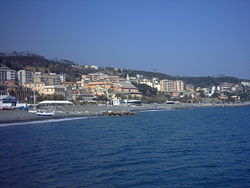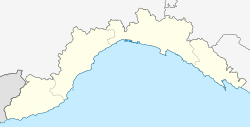Cogoleto (Ligurian: Cogoeuo) is a comune (municipality) in the Metropolitan City of Genoa in the Italian region Liguria, located about 25 kilometres (16 mi) west of Genova. Its territory extends from the sea to the Ligurian Apennines; it is part of the Natural Regional Park of Monte Beigua.
Cogoleto
Cogoeuo | |
|---|---|
| Comune di Cogoleto | |
 | |
| Coordinates: 44°23′22″N 8°38′46″E / 44.38944°N 8.64611°E | |
| Country | Italy |
| Region | Liguria |
| Metropolitan city | Genoa (GE) |
| Frazioni | Lerca, Sciarborasca, Pratozanino |
| Government | |
| • Mayor | Andrea D'Agostino |
| Area | |
• Total | 20.36 km2 (7.86 sq mi) |
| Elevation | 4 m (13 ft) |
| Population (30 June 2017)[2] | |
• Total | 9,119 |
| • Density | 450/km2 (1,200/sq mi) |
| Demonym | Cogoletesi |
| Time zone | UTC+1 (CET) |
| • Summer (DST) | UTC+2 (CEST) |
| Postal code | 16016 |
| Dialing code | 010 |
| Patron saint | St. Lawrence |
| Saint day | August 10 |
| Website | Official website |
Multiple 16th-century sources describe Cogoleto as the birthplace of Christopher Columbus, although his precise origins remain a matter of dipute.[3][4][5]
History
editThe area of Cogoleto is identified in the Roman Peutingerian Table as Hasta, with a bridge (destroyed in World War II by Allied bombings) existing here. The first mention of the town dates to 1039, and in 1091 it was included in Bonifacio del Vasto's Marquisate of Savona. In 1343 it was acquired by the Republic of Genoa.
On April 11, 1800 it was the seat of a battle between the French and Austrian armies. Cogoleto became part of the Kingdom of Sardinia in 1815, following its history in the unification of Italy and modern Italian history.
Main sights
edit- Oratory of St. Lawrence, dating to the 13th century
- Orto Botanico di Villa Beuca, a botanical garden
- Imaginary birthplace of Christopher Columbus
Twin towns
edit- Ober-Ramstadt, Germany, since 1960
- Santa Coloma de Gramenet, Spain, since 1997
- Olympia, Greece, since 2005
- Saint-André-les-Vergers, France, since 2005
Nature conservation
editPart of the municipality territory is within the boundaries of the Parco naturale regionale del Beigua.[6]
Notable people
editReferences
edit- ^ "Superficie di Comuni Province e Regioni italiane al 9 ottobre 2011". Italian National Institute of Statistics. Retrieved 16 March 2019.
- ^ All demographics and other statistics: Italian statistical institute Istat.
- ^ (in Spanish) Garibay y Zamalloa, Esteban de. "Compendio historial de las chronicas y universal historia de todos los reynos de España." 1571 (link to 1628 edition), p. 650. Retrieved 2011-12-08.
- ^ (in Spanish) Castillo, Julián del. "Historia de los Reyes Godos que vinieron de la Scitia de Europa, contra el Imperio Romano, y a España." Por Philippe de Iunta, 1582. p. 143. Retrieved 2011-12-08.
- ^ (in Spanish) Ballesteros Beretta, Antonio. "Cristóbal Colón y el descubrimiento de América" (Volume I). Salvat editores, s.a., 1945. pp. 139–157. Retrieved 2011-02-22.
- ^ "Comuni del Parco". www.parcobeigua.it. Retrieved 2016-02-20.



